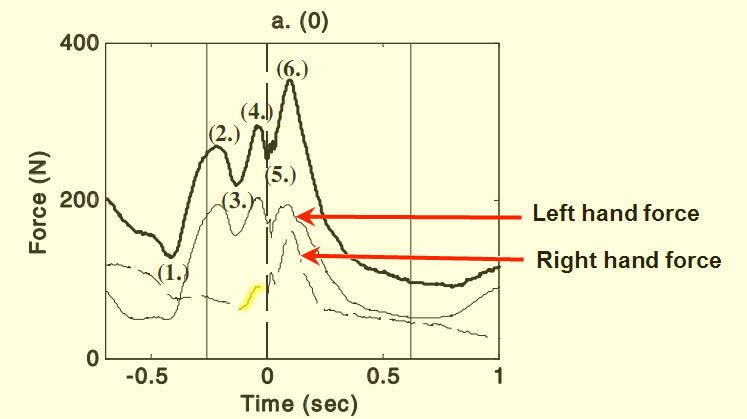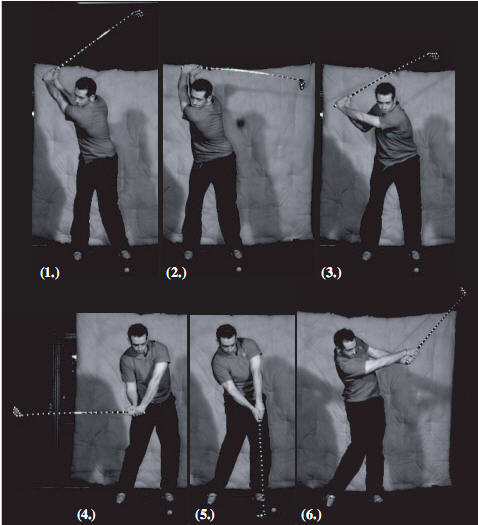Post by imperfectgolfer on Jan 7, 2013 11:51:49 GMT -5
There has been endless debates as to whether a golfer is swinging or swing-hitting, and I have always stated that we need to embed pressure sensors in the shaft to see how much force is being exerted on the grip by the left hand (in a pulling manner) and the right hand (in a pushing manner) to accurately answer this question.
Interestingly, these pressure sensors exist and measurements have been made by researchers.
See this article - dspace.lboro.ac.uk/dspace-jspui/handle/2134/3577
You can freely download a pdf file of that paper from that link and read the entire paper.
Those pressure sensors are of two types and they are amazing.
Unfortunately, the way the experiment was performed and the way the results were presented doesn't answer the debate question re: swinging versus swing-hitting. However, it offers many clues.
The best graph relates to the scratch handicap golfer.

The graph shows the total force exerted on the grip, and it is broken down to left hand forces and right hand forces.
This photo shows where the golfer is during different time points.

I have yellow-colored the area of the right hand force graph that occurs between P5 and P7.
Some crude generalisations that can be inferred from this graph.
The golf swing is mainly a left hand action between P4 and P7.5, and there is very little right hand force being exerted during that time. A small amount of right hand force becomes operant in the mid-late downswing and it reaches its maximum value at impact (yellow-colored area). That fits in with my description of the golf swing - as described in my review papers where the release of PA#4 supplies most of the grip-moving power, and the right hand only contributes some "force" during the later downswing. It certainly shows that BM's theory that there is no force being exerted by the right hand across the shaft at impact is wrong.
Also, note that the left hand force always exceeds the right hand force post-impact between P7 and P7.5, which is the foundation of my biomechanical explanation regarding how a golfer maintains a FLW/intact LAFW from P7 to P7.5+.
Note that the right hand force only increases dramatically between P7.5 and P9 - during the finish swivel action when the club is swivelled onto the inclined plane after P8.
Now that I understand that these pressure sensors already exist, I also realise that we could use them to measure push-pressure exerted by the right hand at PP#1 (which is above the coupling point) and at PP#3 (which is below the coupling point) to answer the important question as to whether the right hand exerts a push-pressure on the shaft below the coupling point between P5 and P6.6 as BM suggests in his rotation-about-the-coupling point theory. In other words, golf researchers actually have the means to prove/disprove the RACP theory - if they set up their experiment correctly.
Jeff.
Interestingly, these pressure sensors exist and measurements have been made by researchers.
See this article - dspace.lboro.ac.uk/dspace-jspui/handle/2134/3577
You can freely download a pdf file of that paper from that link and read the entire paper.
Those pressure sensors are of two types and they are amazing.
Unfortunately, the way the experiment was performed and the way the results were presented doesn't answer the debate question re: swinging versus swing-hitting. However, it offers many clues.
The best graph relates to the scratch handicap golfer.

The graph shows the total force exerted on the grip, and it is broken down to left hand forces and right hand forces.
This photo shows where the golfer is during different time points.

I have yellow-colored the area of the right hand force graph that occurs between P5 and P7.
Some crude generalisations that can be inferred from this graph.
The golf swing is mainly a left hand action between P4 and P7.5, and there is very little right hand force being exerted during that time. A small amount of right hand force becomes operant in the mid-late downswing and it reaches its maximum value at impact (yellow-colored area). That fits in with my description of the golf swing - as described in my review papers where the release of PA#4 supplies most of the grip-moving power, and the right hand only contributes some "force" during the later downswing. It certainly shows that BM's theory that there is no force being exerted by the right hand across the shaft at impact is wrong.
Also, note that the left hand force always exceeds the right hand force post-impact between P7 and P7.5, which is the foundation of my biomechanical explanation regarding how a golfer maintains a FLW/intact LAFW from P7 to P7.5+.
Note that the right hand force only increases dramatically between P7.5 and P9 - during the finish swivel action when the club is swivelled onto the inclined plane after P8.
Now that I understand that these pressure sensors already exist, I also realise that we could use them to measure push-pressure exerted by the right hand at PP#1 (which is above the coupling point) and at PP#3 (which is below the coupling point) to answer the important question as to whether the right hand exerts a push-pressure on the shaft below the coupling point between P5 and P6.6 as BM suggests in his rotation-about-the-coupling point theory. In other words, golf researchers actually have the means to prove/disprove the RACP theory - if they set up their experiment correctly.
Jeff.

